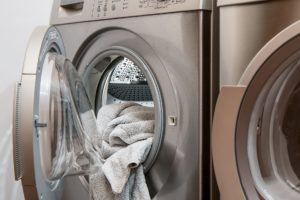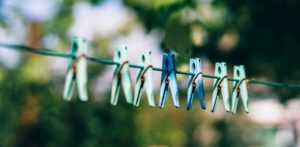How to Wash Pillows

- Pillow hygiene is essential for quality sleep, and regular washing and maintenance can prevent the build-up of fungi, bodily fluids, dust, and dandruff, ensuring a cleaner sleep environment.
- Depending on the pillow type, proper washing techniques vary, and it’s crucial to follow the manufacturer’s care instructions to avoid damaging the pillow’s material during cleaning.
- Regularly using pillow covers, airing out the pillows, and following a scheduled replacement plan based on the pillow type and material can help maintain a hygienic sleep environment and ensure a comfortable and healthy night’s rest.
We spend eight hours every night on our pillows. Without proper care, an abundance of fungi, bodily fluids and oils, dust, and dandruff can build up on the cover or in the pillow’s comfort layers. While changing the pillowcases for regular washing is a good place to start, it may not be enough in the long run.
Unfortunately, pillows can be damaged if you do not wash them properly. Depending on the type of pillow, the care instructions for cleaning can vary.
In this guide, we discuss how to clean pillows according to their filling, the best ways to maintain pillow hygiene between washes, and when you should replace your pillow for a new model.
Pillow Washing Guidelines
While cleaning pillows is rather simple, there are many different ways to clean them, and the wrong way can result in destroyed material. To avoid damaging your pillow, we highly suggest you follow the care instructions that come with the product rather than referring to other sources.
Normally, the manufacturer will provide the best guidelines on how to wash pillows.
However, if you have lost your care instructions and need some sort of guide on how to wash your pillows, we have what you need here.
How to Wash Down Pillows

Unlike other pillow types, you can toss down pillows in your washing machine. If you have a top-load washer— a machine you load from the top instead of the front— we recommend cleaning two pillows at a time. This will help balance out the drum, or the container where clothes are placed in the machine.
Arrange the pillows vertically around the agitator, sometimes called the spindle, found in the middle and set on a gentle cycle. If your machine does not have an agitator, you can place the pillows in the same way or lay them flat.
You don’t need a specific type of washing machine to clean your pillows unless you’re washing a body pillow. Body pillows require an industrial washer due to their size.
Add a little mild liquid detergent and fill the drum with warm water. Choose a cold water rinse cycle and then spin all the excess water from the pillows.
Transfer the pillows to the dryer with two clean tennis or dryer balls. The balls will fluff the pillow filling and speed up the drying process. Tumble dry with low heat until fully dry.
How to Wash Feather Pillows
Feather pillows can be machine-washed as long as there are no tears or holes in the cover.
You’ll want to clean feather pillows two at a time to balance out the drum using a small amount of liquid detergent.
Set the wash cycle to delicate and spin until damp.
To reduce drying time and plump your pillows, place them in a dryer with two tennis balls or dryer balls. This will also break up any clumping that may occur while drying. Feather pillows will take longer to dry. You may need to set the drying time for longer you would for a load of clothes.
How to Wash Memory Foam and Latex Pillows
Unfortunately, you’ll have to hand wash memory foam and latex pillows. Once again, follow the care tag if you have it on hand. Memory foam pillows are delicate and can be easily damaged if not maintained properly. Latex pillows are more sturdy; however, they are still susceptible to mildew and mold if not dried properly.
Dilute laundry detergent in a bucket of water and run the soapy water over the pillow, squeezing gently from time to time until the water runs clear. Repeat the same step with clean water and then press the water from the pillow. Let the pillow dry in the sun or under a fan.
Interested in memory foam? Pair your pillow with a top-rated memory foam mattress to get the best night’s sleep.
How to Wash Polyester Pillows
You can maintain polyester pillows similar to how you would maintain down. Wash two pillows at a time by arranging them vertically around the agitator, or flat if the machine does not have an agitator or a front loader.
Add mild laundry detergent and fill the drum with warm water. Set the rinse cycle to cold and spin until slightly damp. Transfer the synthetic pillows to the dryer with two dryer balls and tumble on low heat until dry.
How to Wash Buckwheat Hull Pillows
Buckwheat pillows are tricky— while the pillow casing can be thrown into the wash with the bedsheets, the buckwheat hulls cannot be cleaned. If the hulls get wet, you’ll have to replace them to avoid mold and loss of support.
You may be concerned that the pillowcase will shrink in the wash— to avoid this accident, wash the pillow cover in cold water and hang dry.
Keeping Your Pillows Clean

After reading about pillows and the grime they collect, you probably want to stop them from gathering as much dirt and bacteria as possible. Here are a few tips.
Use covers. Like high-quality mattress protectors, pillowcases are meant to shield your pillow from foreign particles and liquid spills. As we’ve already established, pillows collect nasty stuff easily. Always using a pillowcase and regularly wash the casing to diminish the likelihood of visible build-up and increase its longevity.
Air out your pillow. Airing out your pillow between washes will keep it smelling fresh and avoid excessive cleaning, which can deteriorate the pillow faster.
For pillows with loose filling— down, feather, or fiberfill— fluffing daily will help retain the pillow’s shape and remove any dust particles that have built up. Another way you can air out your pillow is by hanging the pillow outdoors on a clothesline once a month to keep it smelling pristine.
Sprinkle baking soda over memory foam pillows and leave in sunlight to draw out bad odors. After the pillow has sat for 2 hours, vacuum the baking soda up with an upholstery attachment.
Don’t eat on your bed. It may be tempting to sprawl out on your bed and eat a slice of pizza, but it can have some disastrous effects. Even if your bed has fantastic motion isolation, you still run the risk of spilling or dropping food onto your pillow.
Stains and crumbs invite bacteria and bugs— two organisms you don’t want in a place where you sleep.
Spot clean. Spot-cleaning memory foam pillows will help you avoid cleaning too often. It’s also a great way to clean up juice or dark liquid spills. Just remember that spot cleaning can’t take the place of a thorough cleaning.
Time to upgrade your mattress, too? Check out our mattress guide on finding the best mattress of 2024.
When to Replace Your Pillow
Everyone should have good cleaning habits. There are only so many times your pillow can go through the wash before you have to call it quits.
Typically, if a pillow can no longer be fluffed, it should go into the trash because it’s no longer supportive. It’s also filled with bacteria that cannot be removed with a good cleaning— kind of like a child’s old stuffed animal.
If you are unsure if the pillow is still usable, fold it in two— if it doesn’t resume its natural shape after you release pressure, it can be thrown away.
The scent of mold or mildew is another indicator you need a replacement.
As a general rule of thumb, a pillow with loose filling should be replaced every six months, even if they still fluff well and pass the fold test. Sleeping with a grimy pillow won’t help you keep a clean sleep environment.
While traditional loose-fill pillows should be thrown completely away after six months, adjustable, shredded memory foam or buckwheat pillows only need their filling switched out every six months. Because the pillow’s cover can be regularly washed, you can treat it very much like bedsheets, replacing it when it becomes worn. Washing by the care tag instructions can extend the cover’s life by a couple of years.
Solid memory foam pillows should be changed out every 18 to 36 months.
Because of the material’s density, even the best memory foam pillows are susceptible to mildew and mold if not dried quickly enough. They may also retain body oils, dandruff, and dust mites more easily because they can only be gently cleaned to avoid damage.
To retain a hygienic sleep environment, change out your memory foam pillow every 36 months at a minimum.
Replacing latex foam follows a similar schedule— change it out every two years. Even though latex pillows typically last to up to 10 years, they slowly lose their support over time.
Did We Answer Your Questions?
Hopefully, we answered all your questions regarding basic pillow maintenance. You should give your pillows as much attention as you give your bedsheets. Even though they need to be replaced more often than other bedding, maintaining a healthy, clean sleep environment is essential for a good night’s sleep and your health.
If you are looking into pillows and would like some recommendations, please check out our post on best pillows.

Comments (2) Leave a reply
Thank you very much, this is very helpful
i bought the king size bamboo filled pillow, do i use a pillow case or just the case it comes in and can i put the outer case in the washing machine?